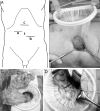Comparison between transverse mini-incision and longitudinal mini-incision for the resection of locally advanced colonic cancer
- PMID: 24833142
- PMCID: PMC4027903
- DOI: 10.9738/INTSURG-D-13-00268.1
Comparison between transverse mini-incision and longitudinal mini-incision for the resection of locally advanced colonic cancer
Abstract
We performed a retrospective review of non-overweight (body mass index ≤ 25 kg/m(2)) patients scheduled to undergo a curative resection of locally advanced colon cancer via a transverse mini-incision (n = 62) or a longitudinal mini-incision (skin incision ≤7 cm, n = 62), with the latter group of patients randomly selected as historical controls matched with the former group according to tumor location. Extension of the transverse mini-incision wound was necessary in 3 patients (5%). Both groups were largely equivalent in terms of demographic, clinicopathological, and surgical factors and frequency of postoperative complications. Postoperative analgesic was significantly less (P = 0.04) and postoperative length of the hospital stay was significantly shorter (P < 0.01) in the transverse mini-incision group. Concerning a mini-incision approach for locally advanced colonic cancer, a transverse incision seems to be advantageous with regard to minimal invasiveness and early recovery compared with a longitudinal incision.
Keywords: Colectomy; Colonic cancer; Mini-laparotomy; Transverse incision.
Figures

Similar articles
-
Comparison of short-term outcomes between laparoscopically-assisted vs. transverse-incision open right hemicolectomy for right-sided colon cancer: a retrospective study.World J Surg Oncol. 2007 May 11;5:49. doi: 10.1186/1477-7819-5-49. World J Surg Oncol. 2007. PMID: 17498289 Free PMC article.
-
[Transverse minilaparotomy as an access route in right colon disease: a valid alternative to midline laparotomy].Chir Ital. 2000 Jan-Feb;52(1):91-6. Chir Ital. 2000. PMID: 10832533 Italian.
-
Right Kocher's incision: a feasible and effective incision for right hemicolectomy: a retrospective study.World J Surg Oncol. 2012 Jun 7;10:101. doi: 10.1186/1477-7819-10-101. World J Surg Oncol. 2012. PMID: 22676778 Free PMC article.
-
Short- and long-term outcomes after transverse versus extended colectomy for transverse colon cancer. A systematic review and meta-analysis.Int J Colorectal Dis. 2019 Feb;34(2):201-207. doi: 10.1007/s00384-018-3186-4. Epub 2018 Nov 6. Int J Colorectal Dis. 2019. PMID: 30402767
-
Laparoscopic colectomy for cancer: an oncologic feasible option.Surg Oncol. 2000 Nov;9(3):127-34. doi: 10.1016/s0960-7404(01)00002-0. Surg Oncol. 2000. PMID: 11356341 Review.
Cited by
-
Enhanced recovery program versus traditional care after hepatectomy: A meta-analysis.Medicine (Baltimore). 2017 Sep;96(38):e8052. doi: 10.1097/MD.0000000000008052. Medicine (Baltimore). 2017. PMID: 28930840 Free PMC article.
References
-
- Ishida H, Nakada H, Yokoyama M, Hayashi Y, Ohsawa T, Inokuma S, et al. Minilaparotomy approach for colonic cancer: initial experience of 54 cases. Surg Endosc. 2005;19(3):316–320. - PubMed
-
- Ishida H, Ishiguro T, Ohsawa T, Okada N, Yokoyama M, Kumamoto K, et al. Curative colectomy via minilaparotomy approach without utilizing specific instruments. Tech Coloproctol. 2010;14(2):153–159. - PubMed
-
- Ishida H, Ishiguro T, Ohsawa T, Okada N, Kumamoto K, Ishibashi K, et al. Oncologic outcome of stages II/III colon cancer treated via minilaparotomy. Int Surg. 2011;96(2):127–134. - PubMed
-
- Ishida H, Ishiguro T, Ishibashi K, Ohsawa T, Okada N, Kumamoto K, et al. Curative resection of transverse colon cancer via minilaparotomy. Int Surg. 2011;96(1):6–12. - PubMed
-
- Ishida H, Ishiguro T, Ishibashi K, Ohsawa T, Kuwabara K, Okada N, et al. Impact of prior abdominal surgery on curative resection of colon cancer via minilaparotomy. Surg Today. 2011;41(3):369–376. - PubMed
Publication types
MeSH terms
LinkOut - more resources
Full Text Sources
Other Literature Sources

